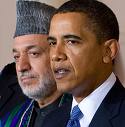Friday
May142010
Afghanistan: Obama & Karzai Split Over Talks with Taliban? (Porter)
 Friday, May 14, 2010 at 8:21
Friday, May 14, 2010 at 8:21  Gareth Porter evaluates Hamid Karzai's visit to Washington for Inter Press Service:
Gareth Porter evaluates Hamid Karzai's visit to Washington for Inter Press Service:U.S. President Barack Obama and Afghan President Hamid Karzai sought to portray a united front on the issue of a political settlement with the Taliban in their joint press conference Wednesday. But their comments underlined the deep rift that divides Karzai and the United States over the issue.
Karzai obtained Obama's approval for the peace jirga scheduled for later this month --- an event the Obama administration had earlier regarded with grave doubt because of Karzai's ostensible invitation to the Taliban to participate.
Afghanistan Analysis: Karzai 2, Obama 1 (Cole)
On the broader question of reconciliation, however, Obama was clearly warning Karzai not to pursue direct talks with the Taliban leadership, at least until well into 2011.
Karzai played down the Taliban role in a peace jirga, saying that it was the "thousands of Taliban who are not against Afghanistan, or against the Afghan people... who are not against America either..." who would be addressed at the conference.
But he also acknowledged that the jirga would discuss how to approach at least some in the Taliban leadership about peace talks.
Karzai said, "Those within the Taliban leadership structure who, again, are not part of al Qaeda or the terrorist networks, or ideologically against Afghanistan's progress and rights and constitution, democracy, the place of women in the Afghan society, the progress that they've made... are welcome."
The "peace consultative jirga", he said, would be "consulting the Afghan people, taking their advice on how and through which means and which speed should the Afghan government proceed in the quest for peace".
Karzai thus made it clear that he would be taking his cues on peace talks with the Taliban from popular sentiment rather than from Washington.
That could not have been a welcome message to the Obama administration, because of Karzai's well-known pattern of catering to views of the Pashtun population, which are overwhelmingly favourable to peace talks with the Taliban.
Obama endorsed the peace jirga, but he limited U.S. support to "reintegration of those [Taliban] individuals into Afghan society".
Obama pointedly referred to what had evidently been a contentious issue in their private meeting --- his insistence that moves toward reconciliation with the Taliban should not go forward until after the U.S. military has carried out Gen. Stanley A. McChrystal's counterinsurgency plan for southern Afghanistan.
"One of the things I emphasised to President Karzai," said Obama, adding "however", to indicate that it was a matter of disagreement, "is that the incentives for the Taliban to lay down arms, or at least portions of the Taliban to lay down arms, and make peace with the Afghan government in part depends on our effectiveness in breaking their momentum militarily."
Obama asserted that "the timing" of the reconciliation process was linked to U.S. military success, because that success would determine when the Taliban "start making different calculations about what's in their interests".
Neither Obama nor Karzai gave any hint that the Afghan president had agreed with that point. Karzai openly sided with tribal elders in Kandahar who were vocally opposed to the U.S. military occupation of Kandahar City and surrounding districts at a large shura Apr. 4.
An administration official who is familiar with the Obama-Karzai meeting confirmed to IPS Thursday that the differences between the two over the issue of peace talks remained, but that the administration regards it as positive that Karzai was at least consulting with Obama on his thinking.
Before the Karzai-Obama meeting, the official said, "A lot of people were jumping to the conclusion that [Karzai and the Taliban] are talking about deals. Now he is talking to us before making any back room deals."
Read rest of article....

 Gareth Porter writes for Inter Press Service
Gareth Porter writes for Inter Press Service